Modified and Simplified Sectional Flexibility of a Cracked Beam
Abstract
This paper presents a new sectional flexibility factor to simulate the reduction of the stiffness of a single-edge open cracked beam. The structural model for crack of the beam is considered as a rotational spring which is related to the ratio of crack depth to the beam height, a/h. The mathematical model of this single-edge open crack beam is considered as an Euler-Bernoulli beam. The modified factor, f(a/h), derived in this paper is in good agreement with previous researchers′ results for crack depth ratio a/h less than 0.5. The natural frequencies and corresponding mode shapes for lateral vibration with different types of single-edge open crack beams can then be evaluated by applying this modified factor f(a/h). Using the compatibility conditions on the crack and the analytical transfer matrix method, the numerical solutions for natural frequencies of the cracked beam are obtained. The natural frequencies and the mode shapes with crack at different locations are obtained and compared with the latest research literature. The numerical results of the proposed cracked beam model obtained by this method can be extended to construct frequency contour. The natural frequencies measured from field can be used in solving the inverse problem to identify cracks in structures.
1. Introduction
A crack in the structure will reduce the structural strength and result in severe damage under critical loading conditions. The major issue of the structural health monitoring is to detect crack depth and location in the present study. The model with linear elastic fracture mechanics and Euler-Bernoulli beam theory are being widely used in the recent research literatures. The cracked beam is modeled as two-segment beam with the crack simulated as a rotational spring. The crack of the beam is considered as a local flexibility which is a function of the crack depth.
Sih [1] proposed strain energy density factor theory to discuss the all mixed-mode crack extension problems. The strain energy density factor is a linear elasticity function of the mixed-mode stress intensity factors. Tada et al. [2] presented the stress intensity factors of different modes due to general loading. The presented model introduced the local flexibility matrix from the stress intensity factors. Nobile [3] proposed a simple method for obtaining approximate stress intensity of straight cracked beams. The system takes account of the elastic crack tip stress singularity while using the elementary beam theory. Dimarogonas and Paipetis [4] introduced a general stiffness matrix for cracked structural members to model the respective dynamic system. The local flexibility can be derived further from the general stiffness matrix. Chondros et al. [5] developed a continuous cracked beam vibration theory for the lateral vibration of cracked Euler-Bernoulli beams with single-edge or double-edge open cracks. The crack was modeled as a continuous flexibility using the displacement field. Anifantis and Dimarogonas [6] studied the system stability of the cracked column with vertical load. The method developed a general flexibility matrix to express the local flexibility of a beam with a single-edge crack. Ostachowicz and Krawczuk [7] developed a new local flexibility which was derived from the stress intensity factor by Anifantis and Dimarogonas [6].
In order to obtain the natural frequencies of the crack beam, finite element method was used to compute the eigensolutions in the recent literatures. The order of the determinants increases as the degree of freedom increases in finite element method. In order to reduce the order of the determinants, Lin et al. [8] proposed using transfer matrix for beams with arbitrary number of cracks. The method uses only four unknown constants which can be solved through satisfying four boundary conditions. Lin and Chang [9] used the analytic transfer matrix method to solve eigensolutions of a cracked cantilever beam. The eigenfunctions obtained in this method are analytical solutions. The dynamic responses can be obtained by this method, and the solutions converge quite fast. Alsabbagh et al. [10] presented a new simplified formula for the stress correction factor by using strain energy density approach. A modified factor for local flexibility was used in solving the characteristic equation of the cracked beam. Lin [11] used the Timoshenko beam theory and transfer matrix method to solve the direct and inverse problems of simply supported beam with a single-edge open crack. The location and crack size of the beam can be determined by the method presented. The theoretical results are also validated by a comparison with experimental measurements.
2. Derivation of Stress Intensity Factor
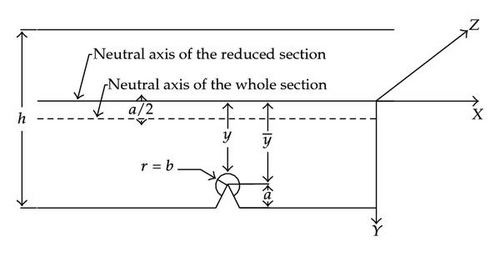
3. Calculation of the Equivalent Flexibility in the Crack Beam
4. Free Vibration of a Cracked Beam


5. Calculation of Natural Frequencies
6. Numerical Results
In order to verify the procedure presented in this paper, results obtained by applying this method are compared with the available data for single-edge open cracked beam. A 300 mm simple supported beam of cross-section 20 × 20 mm2, with modulus of elasticity E = 2.06 × 1011 N/m2, the density ρ = 7800 kg/m3, the crack is located at the position 240 mm and crack depth a = 8 mm.
In this research, small crack depth ratio which implies early stage of structure damage is considered. The comparison of data obtained by the proposed method and previous research is shown in Figure 4. The stress intensity factor of the present model and those in [2, 12] are rather close to each other for small crack depth ratio a/h.
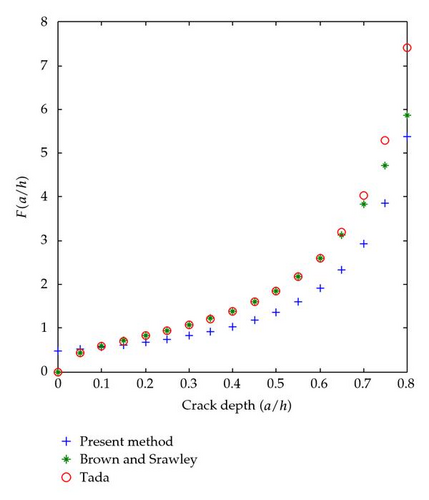
Three generalized loading conditions, bending, tension, and torsion, on a cracked beam were considered to evaluate sectional flexibility in the past literature. Beams are mainly affected by bending moment in most loading cases; therefore only bending effects are considered in evaluating the simplified cracked section flexibility. The results of the proposed method of non-dimensional cracked section flexibility are compared with those of previous research in Figure 5. The results of this simplified method and those of [5, 7] are in good agreement for small crack depth ratio a/h. A cracked beam with a/h greater than 0.5 is already severely damaged and is not suitable for applying this sectional flexibility model.

The first five natural frequencies of the uncracked beam are calculated as ω01 = 517.85, ω02 = 2071.4, ω03 = 4660.64, ω04 = 8285.58, and ω05 = 12946.22 Hz. The ratios of natural frequencies between cracked beam and uncracked beam are listed in Table 1. The variation of natural frequency ratio with the crack depth of this simply supported beam with a crack located at the section (L1/L = 0.8) for the first five modes is plotted as in Figure 6.
| Crack location | Crack depth | Natural frequency ratio | ||||
|---|---|---|---|---|---|---|
| L1/L | a/h | ω1/ω01 | ω2/ω02 | ω3/ω03 | ω4/ω04 | ω5/ω05 |
| 0.8 | 0.0 | 1.0000 | 1.0000 | 0.9999 | 1.0000 | 0.9999 |
| 0.8 | 0.1 | 0.9966 | 0.9912 | 0.9913 | 0.9967 | 0.9999 |
| 0.8 | 0.2 | 0.9918 | 0.9792 | 0.9803 | 0.9927 | 0.9999 |
| 0.8 | 0.3 | 0.9850 | 0.9628 | 0.9660 | 0.9876 | 0.9999 |
| 0.8 | 0.4 | 0.9747 | 0.9394 | 0.9474 | 0.9814 | 0.9999 |
| 0.8 | 0.5 | 0.9581 | 0.9052 | 0.9237 | 0.9737 | 0.9999 |
| 0.8 | 0.6 | 0.9292 | 0.8544 | 0.8943 | 0.9648 | 0.9999 |
| 0.8 | 0.7 | 0.8735 | 0.7800 | 0.8605 | 0.9551 | 0.9999 |
| 0.8 | 0.8 | 0.7525 | 0.6809 | 0.8271 | 0.9459 | 0.9999 |
| 0.8 | 0.9 | 0.4791 | 0.5825 | 0.8021 | 0.9392 | 0.9999 |
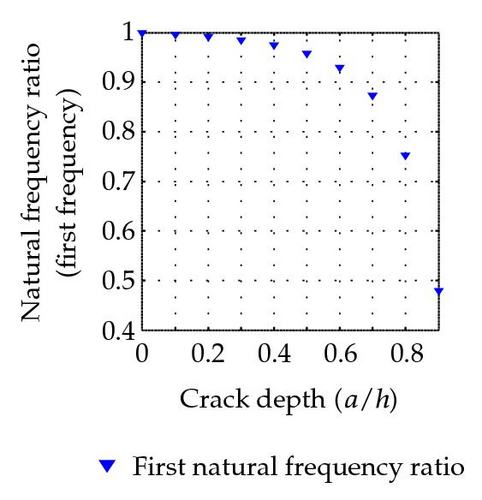
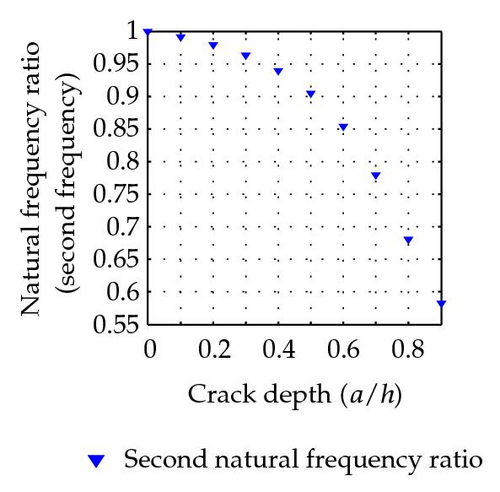
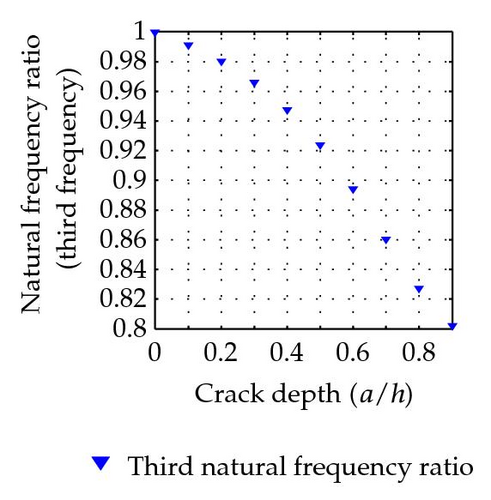

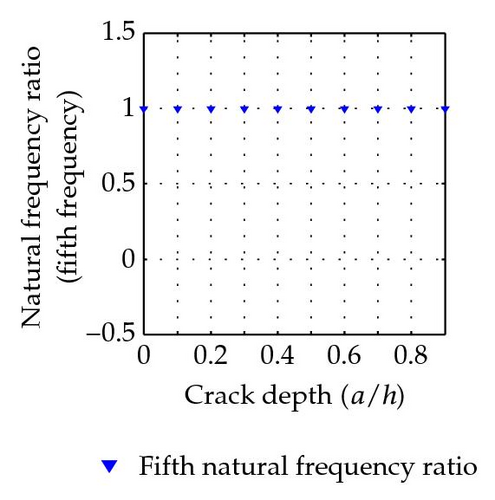
With a crack located at the center of the beam, the ratios of natural frequencies between cracked beam and uncracked beam are listed in Table 2. The variation of natural frequency ratio with the crack depth of a simply supported beam with a crack located at (L1/L = 0.5) is shown in Figure 7 for the first five modes.
| Crack location | Crack depth | Natural frequency ratio | ||||
|---|---|---|---|---|---|---|
| L1/L | a/h | ω1/ω01 | ω2/ω02 | ω3/ω03 | ω4/ω04 | ω5/ω05 |
| 0.5 | 0.0 | 1.0000 | 1.0000 | 0.9999 | 1.0000 | 0.9999 |
| 0.5 | 0.1 | 0.9902 | 1.0000 | 0.9904 | 1.0000 | 0.9905 |
| 0.5 | 0.2 | 0.9770 | 1.0000 | 0.9778 | 1.0000 | 0.9786 |
| 0.5 | 0.3 | 0.9586 | 1.0000 | 0.9613 | 1.0000 | 0.9636 |
| 0.5 | 0.4 | 0.9321 | 1.0000 | 0.9391 | 1.0000 | 0.9448 |
| 0.5 | 0.5 | 0.8927 | 1.0000 | 0.9094 | 1.0000 | 0.9218 |
| 0.5 | 0.6 | 0.8314 | 1.0000 | 0.8699 | 1.0000 | 0.8948 |
| 0.5 | 0.7 | 0.7328 | 1.0000 | 0.8199 | 1.0000 | 0.8654 |
| 0.5 | 0.8 | 0.5723 | 1.0000 | 0.7634 | 1.0000 | 0.8377 |
| 0.5 | 0.9 | 0.3245 | 1.0000 | 0.7144 | 1.0000 | 0.8175 |
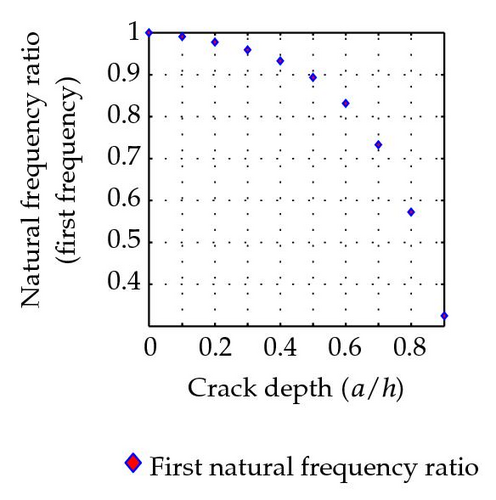
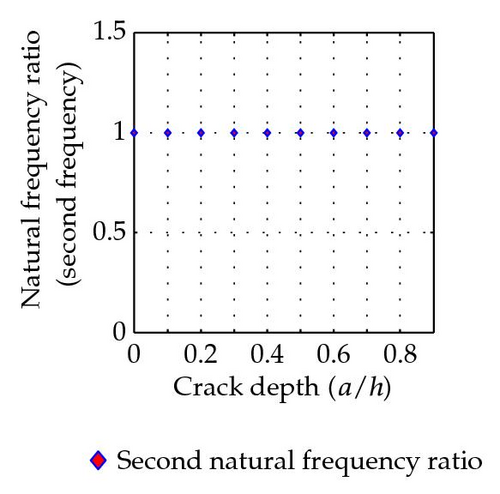
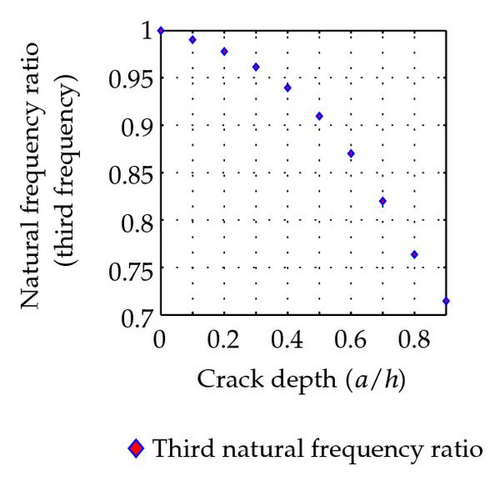
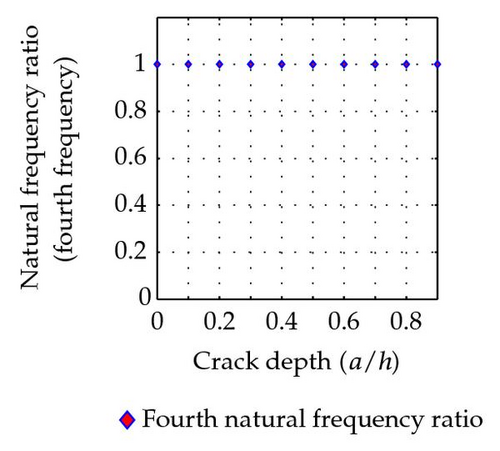
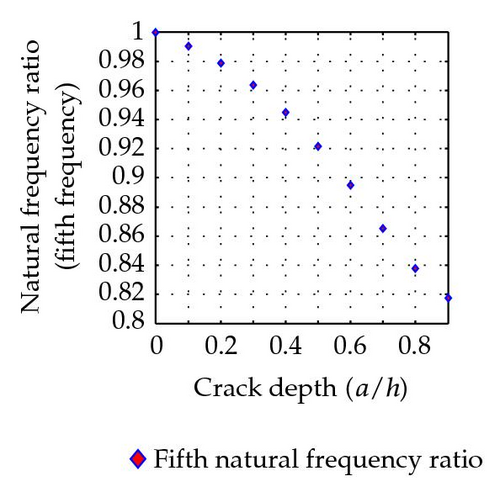
It is quite obvious that the natural frequencies decrease due to the existence of cracks. That is due to the cracked beam becoming more flexible due to the reduction of moment of inertia of the section property.
Figures 8(a)–8(e) show the first five mode shapes of a cracked simply supported beam with single open crack at L1/L = 0.8, crack ratio a/h = 0.4, and normalized amplitude Y/Ymax . It is obvious that the mode shapes all show turning point at crack location L1/L = 0.8.
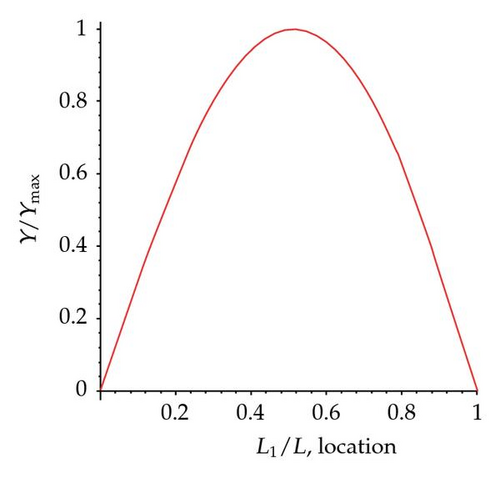
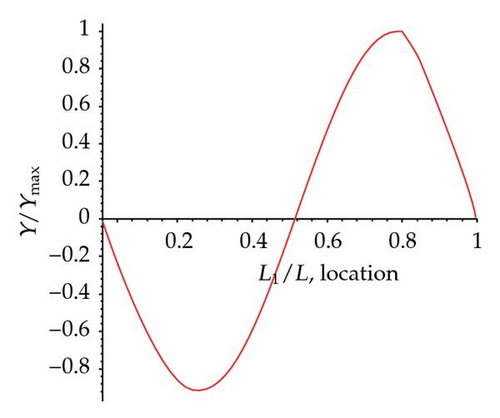

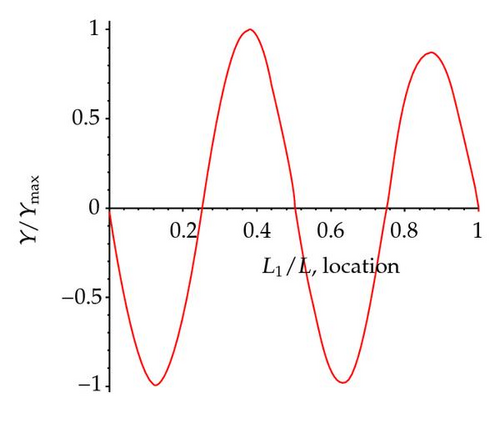
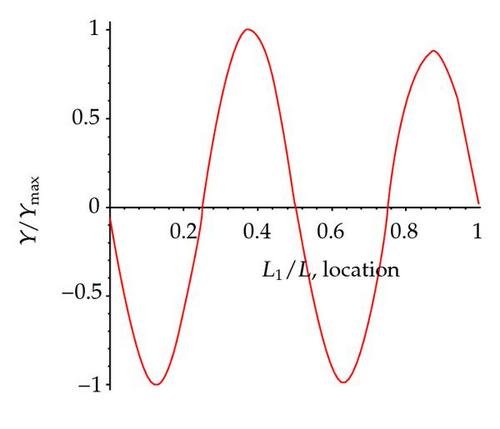
7. Conclusion
The simplified stress intensity factor and flexibility were derived utilizing the crack beam theorem of Nobile [3] and Dimarogonas [4, 5]. The order of polynomial functions for crack depth ratio a/h is reduced, because, with a crack depth ratio a/h < 0.5, the high-order terms will approach to 0. Therefore, these higher-order arithmetic terms can be neglected and, in order to predict the early stage of structural damage, crack depth ratio a/h should be less than 0.5. The simplified stress intensity factor and flexibility are compared with the recent literature, and the numerical results are found to be in good agreement.
If the crack is right on the position of nodal point of certain modes, frequencies ratio shows no difference with ωi/ω0i = 1. For example, the crack at 0.8 L is also a nodal point of the fifth mode which gives the numerical result as ω5/ω05 = 1. The numerical results obtained by this method are in good agreement with the actual vibration response of a simply supported beam. The turning points of certain mode shape function reveal the information about crack location. For the case with a crack at 0.8 L, it can be seen obviously from shape function of mode two, mode three, and mode four with a turning point at 0.8 L.
The simplified stress intensity factor and flexibility of this method can be further extended to construct frequencies ratio contours for beams with cracks. The natural frequencies obtained by applying this model can be used to verify the experimental measurements in a similar way to that in [11]. The location and crack depth of a beam can then be identified as an inverse problem by matching up field measurement of frequencies of a cracked beam.




